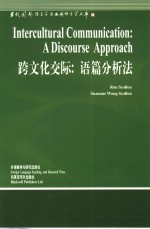

跨文化交际 语篇分析法PDF电子书下载
- 电子书积分:11 积分如何计算积分?
- 作 者:(美)RonScollon,(美)SuzanneWongScollon著贾玉新导读
- 出 版 社:北京:外语教学与研究出版社
- 出版年份:2000
- ISBN:756001934X
- 页数:276 页
1 What is a Discourse Approach? 1
The Topic 2
Professional communication 3
Interdiscourse communication 4
Discourse 5
The Limits of Language 5
Languages is ambiguous by nature 6
Preface by Halliday 9
王宗炎序 10
We must draw inferences about meaning 10
Our inferences tend to be fixed,not tentative 10
What is Successful Interdiscourse Professional Communication? 11
Our inferences are drawn very quickly 11
Expecting things to go wrong 12
Dealing with miscommunication 13
Increasing shared knowledge 13
Two Approaches to Interdiscourse Professional Communication 13
导读 13
2How,When,and Where to Do Things with Language 16
Sentence Meaning and Speaker s Meaning 18
Speech Acts,Speech Events,and Speech Situations 19
Grammar of Context 21
Seven Main Components for a Grammar of Context 22
Scene 24
Key 26
List of Figures 27
Participants 27
Series Editor s Preface 28
Message form 28
Sequence 29
Preface 29
Co-occurrence patterns,marked and unmarked 30
Manifestation 31
3 Interpersonal Politeness and Power 33
Communicative Style of Register 33
Face 34
The Paradox of Face:Involvement and Independence 36
The“Self”as a Communicative Identity 36
Politeness Strategies of Involvement and Independence 38
Linguistic Strategies of involvement:some examples 40
Linguistic Strategies of independence:some examples 41
Politeness(or Face)Systems 41
Power(+P,-P) 42
Distance(+D,-D) 43
Weight of imposition(+W,-W) 43
Three Politeness Systems:Deference,Solidarity,and Hierarchy 44
Deference politeness system(-P,+D) 44
Solidarity politeness system(-P,-D) 45
Hierarchical politeness system(+P,+/-D) 45
Miscommunication 47
4Conversational Inference:Interpretation in Spoken Discourse 50
How Do We Understand Discourse? 51
Cohesive Devices:Lexical and Grammatical 53
Reference 53
Conjunction 54
Verb forms 54
The causal conjunction“because” 55
Cognitive Schemata or Scripts 56
World knowledge 58
Adjacency sequences 59
Prosodic Patterning:Intionation and Timing 60
Intonation 60
Timing 63
Metacommunication 66
Non-sequential processing 69
Interactive Intelligence 72
5 Topic and Face:Inductive and Deductive Patterns in Discourse 74
What Are You Talking About? 74
Topic,Turn Exchange,and Timing 75
The call-answer-topic adiacency sequence 76
The call 76
The answer 77
The introduction of the caller s topic 77
Deductive Monologues 78
The Inductive Pattern 79
Inside and outside encounters 80
Hierarchical Confucian relationships and topic introduction 81
The false east-west dichotomy 82
Face:Inductive and Deductive Rhetorical Strategies 83
Topics and Face Systems 85
Face Relationships in Written Discourse 87
Essays and press releases 89
The press release:implied writers and implied readers 90
The essay:a deductive structure 91
Limiting Ambiguity:Power in Discourse 92
6 Ideologies of Discourse 94
Three Concepts of Discourse 94
The Utilitarian Discourse System 98
Ideology of the Utilitarian discourse system 99
The Enlightenment:reason and freedom 100
Kant s view of the“Public”Writer 101
Bentham and Mill s Utilitarianism 101
Socialization in the Utilitarian discourse system 104
Froms of discourse in the Utilitarian discourse system 106
The Panopticon of Bentham 112
Face systems in the Utilitarian discourse system 113
Internal face systems:liberté,égalité, fraternité 114
Multiple Discourse Systems 117
7 What is Culture? Intercultural Communication and Stereotyping 122
How Do We Define“Culture”? 125
Culture and Discourse Systems 127
Ideology 128
Face systems 129
Forms of discourse 137
Socialization 148
Cultural Ideology and Stereotyping 154
Negative Stereotypes 158
Positive Stereotypes,the Lumping Fallacy,and the Solidarity Fallacy 159
Differences Whice Make a Difference:Discourse Systems 161
8 Corporate Discourse 164
Discourse Systems 164
Voluntary and involuntary discourse systems 166
Five Characteristic Discourse Systems 168
An Outline Guide to the Study of Discourse Systems 170
The Corporate Discourse System(Corporate Culture) 172
Ideology 173
Socialization 178
Forms of discourse 183
Face systems 191
The size and scope of corporate discourse systems 192
The Professional Discourse System(ESL Teachers) 194
9 Professional Discourse 194
Ideology 195
Socialization 198
Forms of discourse 200
Face systems 202
Other professional discourse systems 203
10 Generational Discourse 205
Involuntary Discourse Systems 205
The ideologies of American individualism 207
Four generations of Americans 209
The shifting ground of American individualism 221
Asian Generational Discourse Systems 223
Communication Between Generations 225
11 Gender Discourse 229
Intergender Discourse 229
Directness or indirectness? 229
Different interpretive frames 232
The origin of difference:ideology and paradox 237
The maintenance of difference:socialization 240
Messages and metamessages:forms of discourse 242
The struggle for equality,the struggle for power 243
Further Research on Gender Discourse Systems 244
Discourse Systems and the Individual 245
Intersystem Communication 248
References 253
The Research Base 253
References for Further Study 257
Index 267
文库索引 272
- 《水面舰艇编队作战运筹分析》谭安胜著 2009
- 《东北民歌文化研究及艺术探析》(中国)杨清波 2019
- 《分析化学》陈怀侠主编 2019
- 《白雪公主分面包 分数》(韩)车宝金文 2016
- 《大学英语教学的跨文化交际视角研究与创新发展》许丽云,刘枫,尚利明著 2020
- 《影响葡萄和葡萄酒中酚类特征的因素分析》朱磊 2019
- 《仪器分析技术 第2版》曹国庆 2018
- 《近代中国分省人文地理影像采集与研究 甘肃》《近代中国分省人文地理影像采集与研究》编写组 2019
- 《全国普通高等中医药院校药学类专业十三五规划教材 第二轮规划教材 分析化学实验 第2版》池玉梅 2018
- 《跨文化交际背景下的中西文化比较研究》任永进,贺志涛著 2019
- 《SQL与关系数据库理论》(美)戴特(C.J.Date) 2019
- 《魔法销售台词》(美)埃尔默·惠勒著 2019
- 《看漫画学钢琴 技巧 3》高宁译;(日)川崎美雪 2019
- 《优势谈判 15周年经典版》(美)罗杰·道森 2018
- 《社会学与人类生活 社会问题解析 第11版》(美)James M. Henslin(詹姆斯·M. 汉斯林) 2019
- 《海明威书信集:1917-1961 下》(美)海明威(Ernest Hemingway)著;潘小松译 2019
- 《迁徙 默温自选诗集 上》(美)W.S.默温著;伽禾译 2020
- 《上帝的孤独者 下 托马斯·沃尔夫短篇小说集》(美)托马斯·沃尔夫著;刘积源译 2017
- 《巴黎永远没个完》(美)海明威著 2017
- 《剑桥国际英语写作教程 段落写作》(美)吉尔·辛格尔顿(Jill Shingleton)编著 2019
